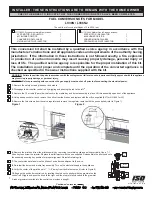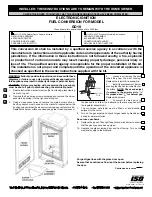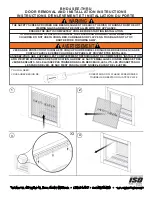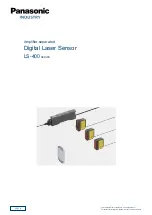
Page 28
Studio Reference
IIIII
&
II
II
II
II
II
Professional Studio Amplifiers
Sensitivity:
A three-position switch inside the
P.I.P. com-
partment used to select the input sensitivity for both chan-
nels: 0.775 or 1.4 volts for standard 1 kHz power, or a 26
dB voltage gain.
Meter On/Off:
A two-position switch behind the front
panel used to turn the front panel meters on or off.
Meter Display Mode:
A two-position switch behind the
front panel used to set the display mode for the front
panel meters. Display modes include dynamic range of
the output signal in dB or output levels in dB.
Ground Lift:
A two-position back panel switch used to
isolate the input phone jack and AC (chassis) grounds.
Reset:
A two-position back panel switch used to reset the
AC mains circuit breaker.
Indicators
Enable:
This indicator shows the on/off status of the unit’s
low-voltage power supply.
Signal:
Each channel has a signal indicator that flashes
to show audio output.
IOC:
Each channel has an
IOC indicator that flashes if the
output waveform differs from the input waveform by 0.05%
or more. The LEDs act as sensitive distortion indicators to
provide
proof of distortion-free performance. In Parallel-
Mono mode the channel 2
IOC light stays on.
ODEP:
Each channel has an
ODEP indicator that shows
the channel’s reserve energy status. Normally, the LEDs
are brightly lit to show that reserve energy is available. In
the rare event that a channel has no reserve, its indicator
will dim in proportion to
ODEP limiting. An ODEP indicator
may also turn off under other more unusual circum-
stances (see Section 4.3).
Dynamic Range /Level Meter:
Each channel has a five-
segment meter that displays either the dynamic range of
the output signal in dB or the output level in dB. (From the
factory, the amplifier is set to display dynamic range.) As
dynamic range meters, they show the ratio of the peak to
average power of each channel. As output level meters
they show how high the output levels are relative to stan-
dard 1 kHz power.
Input/Output
Input Connector:
Two balanced phone jacks on the
back panel and two balanced three-pin XLR connectors
on the factory-installed P.I.P.-FX (see Section 8 for infor-
mation on optional
P.I.P. modules).
Input Impedance:
Nominally 10 K ohms, balanced.
Nominally 5 K ohms, unbalanced.
Input Sensitivity:
Settings include 0.775 volts or 1.4 volts
for standard 1 kHz power, or a 26 dB voltage gain (see
Section 4.4 for more information).
Output Connectors:
Two sets of color-coded 5-way
binding posts for each channel (for connecting banana
plugs, spade lugs or bare wire).
Output Impedance:
Less than 10 milliohms in series with
2.5 microhenries.
DC Output Offset:
(Shorted input) ±2 millivolts.
Output Signal
Stereo:
Unbalanced, two-channel.
Bridge-Mono:
Balanced, single-channel. Channel 1 con-
trols are active; channel 2 should be turned down.
Parallel-Mono:
Unbalanced, single-channel. Channel 1
controls are active; channel 2 is bypassed.
Protection
If unreasonable operating conditions occur, the protec-
tion circuitry limits the drive level to protect the output
stages especially in the case of elevated temperature.
Transformer overheating will result in a temporary shut-
down. Controlled slew-rate voltage amplifiers protect the
unit against RF burnouts. Input overload protection is fur-
nished at the amplifier input to limit current.
Turn On:
The four second turn-on delay prevents dan-
gerous turn-on transients. To change the turn-on delay
time, contact Crown’s Technical Support Group.
Construction
Steel chassis with durable black finish, aluminum front
panel with super-gloss Imron
®
finish, Lexan overlay, and
a specially designed flow-through ventilation system from
front to side panels.
Cooling:
Convection cooling with assistance from the
computerized, on-demand proportional cooling fan.
Dimensions:
Standard 19 inch (48.3 cm) rack mount width
(EIA RS-310-B), 7 inch (17.8 cm) height, 16 inch (40.6 cm)
depth behind mounting surface and 2.75 inch (7 cm) protru-
sion in front of mounting surface.
Approximate Weight:
Center of gravity is about 6 inches
(15.2 cm) behind the front mounting surface.
Studio Reference
I
: 60 pounds, 11 ounces (27.6 kg)
net; 74 pounds, 3 ounces (33.7 kg) shipping weight.
Studio Reference
II
: 56 pounds, 2 ounces (25.5 kg) net;
69 pounds, 10 ounces (31.6 kg) shipping weight.














































